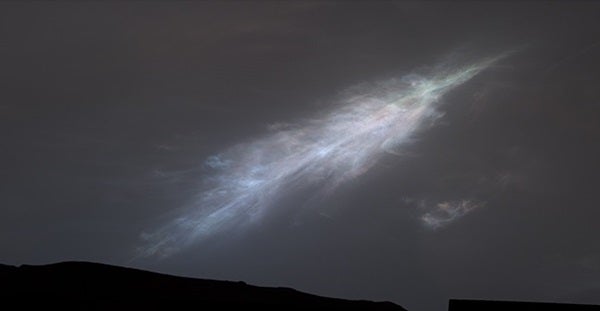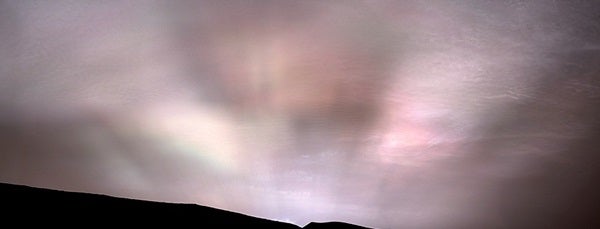NASA’s Mars Curiosity rover added another feather to its cap after photographing wispy and colorful clouds on Mars, building upon a cloud survey done in 2021.
In the panoramic mosaic photo taken last month, the cloud’s fluttery shape displays a colorful pattern caused by a natural phenomenon known as iridescence. This occurrence is due to the diffraction of sunlight through small water droplets, or in this case, through small particles of dry ice, creating a pastel sheen over an object.
“Where we see iridescence, it means a cloud’s particle sizes are identical to their neighbors in each part of the cloud,“ said Mark Lemmon, an atmospheric scientist with the Space Science Institute, in a NASA news release. “By looking at color transitions, we’re seeing particle size changing across the cloud. That tells us about the way the cloud is evolving and how its particles are changing size over time.”
Just a few days later, the rover took another unique image of sunbeams peeking out from behind cloud formations, features known as crepuscular rays. (The contrast was enhanced in the image above.) This is the first time this type of light pattern was caught on Mars.
Both images are part of a survey being conducted from January to mid-March. The survey first began in 2021 and focused on studying noctilucent, or night shining clouds. Martian clouds are often located some 37 miles (60 kilometers) above the ground and are usually filled with water ice. However, the clouds in these images are believed to reside higher in the atmosphere. In that case, the beautiful clouds pictured here are most likely made of frozen carbon dioxide, or dry ice.
Curiosity was launched to the planet in 2011 with the goal of studying martian environments and geology, as well as searching for biomarkers suggestive of past or present life on the Red Planet. By now studying the planet’s clouds in surveys like this, Curiosity is offering insight into Mars’ atmospheric composition, winds, and overall weather patterns.











